Have you ever wanted to bonsai native plants? Here is an outline of what bonsai culture is, what plants work and some resources to draw on.
What does bonsai culture mean?
Contrary to popular opinion, bonsai trees are not genetically altered in any way. Rather, trees are miniaturized through careful culture. Even though a tree might be huge in the wild, growing the same species in a small pot will naturally stunt its growth. “Bonsai culture” means trimming the roots, snipping off leaves which are too large, and pruning the trunk and branches of the tree to attain the desired shape. Some effects are also produced by wrapping wire around the branches and bending them into a gnarled shape to simulate greater age. For inspiration, go outside, look at the trees around you, and try to imitate these natural forms.
Desirable qualities of bonsai include:
- a strong, prominent root system
- a thick trunk
- heavy lower branches
- small leaves, flowers, and fruit.
Leaf size can be reduced through bonsai culture; flowers and fruit cannot. Therefore, it’s a good idea to start with a plant that has smaller flowers in the first place, and scale the tree’s size to match.
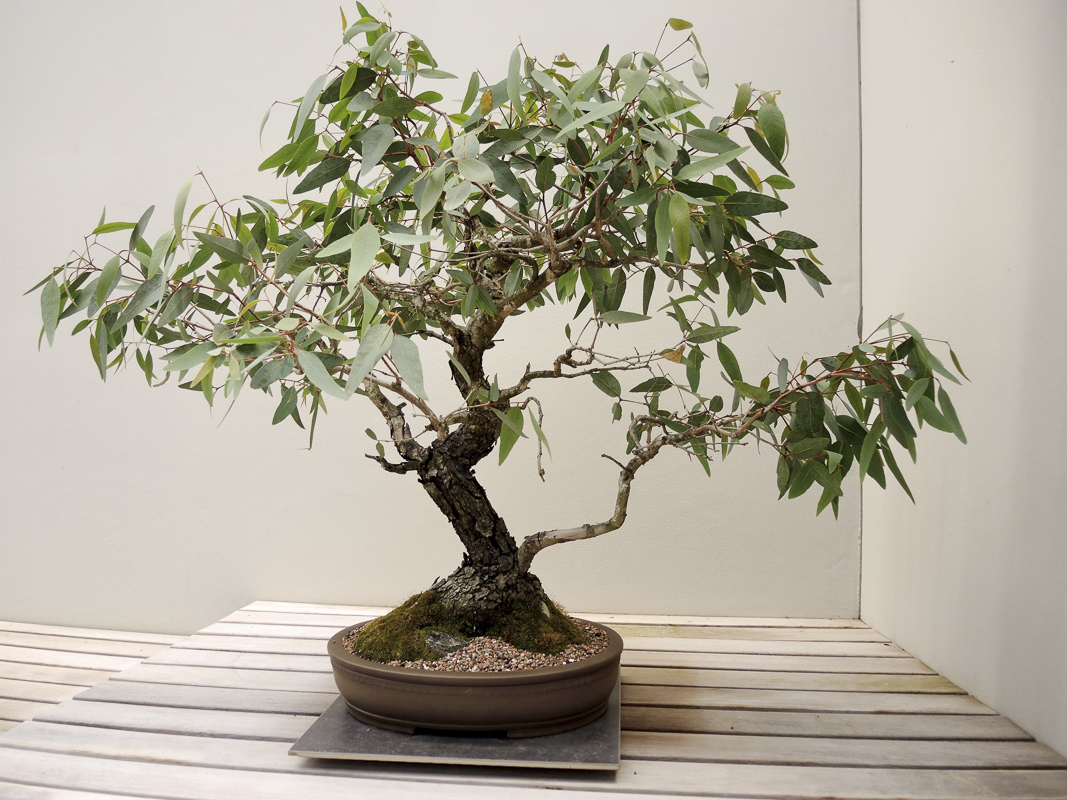
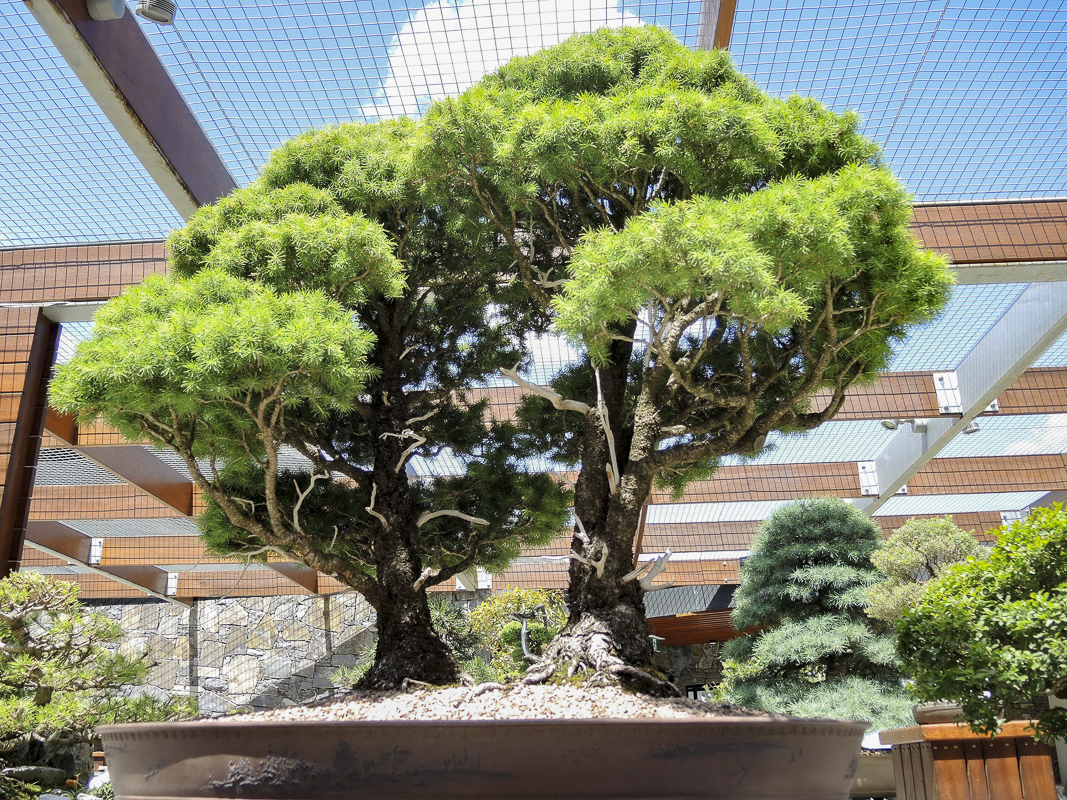
Emulating old plants
Although many bonsai specimens are quite old, it is very easy to obtain the appearance of age in just a few years by planting in a large, deep pot or even outside in the ground, and by allowing the lower branches to grow out, pruning only the top of the tree. This will rapidly increase trunk size and thicken lower branches, giving your tree a natural taper and much “older” look. The root ball can then be gradually trimmed off (not more than one third at a time) and prepared for placement in a shallow bonsai pot. Always trim off a similar amount of foliage when pruning the roots in order to conserve moisture.
Traditional bonsai are grown outdoors, but in the last 20 years, many enthusiasts have begun to grow tropical and subtropical species in their homes. These indoor bonsai are much easier to maintain. Like any other houseplant, they do not require special soil or daily watering, and their beauty can be enjoyed year-round.

Where to Start
Sourcing plants from the nursery
Australia offers some beautiful species for indoor bonsai. These can be obtained from local nurseries in. Healthy, nursery grown specimens with evenly spaced branches offer the most flexibility in styling, but twisted, windblown, and lopsided trees are always desirable as long as they are disease-free. These contorted specimens can provide a “bonsai” look very quickly.
Collecting plants
Collecting plants growing naturally is often the best way to begin a bonsai. Wind, fire, drought, lightning, and plain hard luck can dwarf and contort trees into amazing shapes. Obviously collection from national or conservation parks and nature reserves is not acceptable. But sometimes a suitable plant can be located on your own land. If you find such a tree, think hard about what kind of bonsai it would make. If you wish to collect it, grab your shovel, and think hard again. Be sure you are committed to caring for your tree as a friend. Don’t dig up a novelty whose charm will pass. Whenever you collect, always refill any holes you dig to prevent soil erosion, and offer to plant a new tree in place of the old.
Collecting is best in the spring. Clear away any underbrush and some of the topsoil and check the trunk for disease or rot. If the tree appears healthy, dig a narrow trench around the drip circle (where the branches end) and cut the thick roots with a sharp knife, then refill the trench with soil. If you can return to water your tree on occasion, do so.
After a few months
After a few months, the tree will have grown new roots nearer to the trunk, and you can finish digging it up. If you can only make one trip, trim off about a third of tree’s leaves and/or longest branches to conserve moisture and dig a conical hole from the drip circle inward. In either case, quickly get your tree to a shaded, moist, sheltered site where it can rest and recuperate. Do not immediately attempt any further root pruning. Pant it on your property or in a large container and allow the tree to rest until the following spring.
Whether bought or collected, a new tree in your home is a mystery that you should take the time to study. Before starting to prune and shape your tree, live with it a while and get to know its character. Imagine what it will look like pruned into different shapes, or how it might appear in the future. The two of you will be living together for a long time.
Australian species for bonsai
Sun lovers
Most of the species below are sun lovers, although some will tolerate light shade. All benefit from spending the summer outdoors, but acclimatise gradually. Place them in a semi-shady position with protection from strong winds, and gradually move them to a sunnier position. In autumn, simply follow this procedure in reverse before bringing them back inside.
Most of these plants are subtropicals, which means that they need a cool, dry rest in winter. The fastest way to kill these plants indoors is overwatering during this period. Always use a pot with a drainage hole!
Use your fingers to check the top 25 mm (1 inch) of soil. If it’s still moist, don’t water.
All use a lot of water
On the other hand, all of these species use a lot of water in hot weather, so check the pot every day in summer. The best way to water in summer is to put the whole pot in a bucket of water up to the lip of the pot for about fifteen minutes or until the top of the soil appears damp. Then just let it drain and leave it be until the top 25 mm (1inch) of soil has dried out. In winter, water over the surface of the soil, then let it dry down about 50 mm (2 inches) before watering again. All plants benefit from additional humidity in the home during the central heating season. If you don’t already have a humidifier, consider purchasing an inexpensive cool mist unit. Humidity is good for you, too.
Use a potting soil mixture of one part earthworm castings or good black earth, one part peat moss, and one part well-rinsed coarse builder’s sand, orchid growing medium, or bonsai soil. Any standard houseplant fertilizer can be used. It is wiser to use these products at half strength every two weeks than at full strength once a month. Discontinue feeding as summer ends to allow the plants to “harden off” in autumn. Begin feeding again as soon as growth starts in spring.
Acacia
Acacias are trees and shrubs mostly grown for their small yellow flowers. As bonsai prune back severely in early spring as they are prolific growers. All acacias need as much light as possible. Turn often to maintain even growth. In summer, put them out on the patio for fresh air, and leave out until night temperatures start to fall below 13 degrees C (55 degrees F). They like a lot of water and fertiliser when in active growth. They require cool conditions (not less than 10 C; 50 F) and less water in winter, although they should never be allowed to dry completely. If they decide to drop their leaves in winter, simply keep them barely moist until new growth appears in spring.
Suggestions for bonsai are Acacia paradoxa (Kangaroo Thorn), A. dealbata and A. podalyriifolia (Queensland silver wattle). Other suggestions are here.
Banksia
Banksias are also amenable to bonsai culture. Here is Banksia (robur) and Banksia integrifolia.
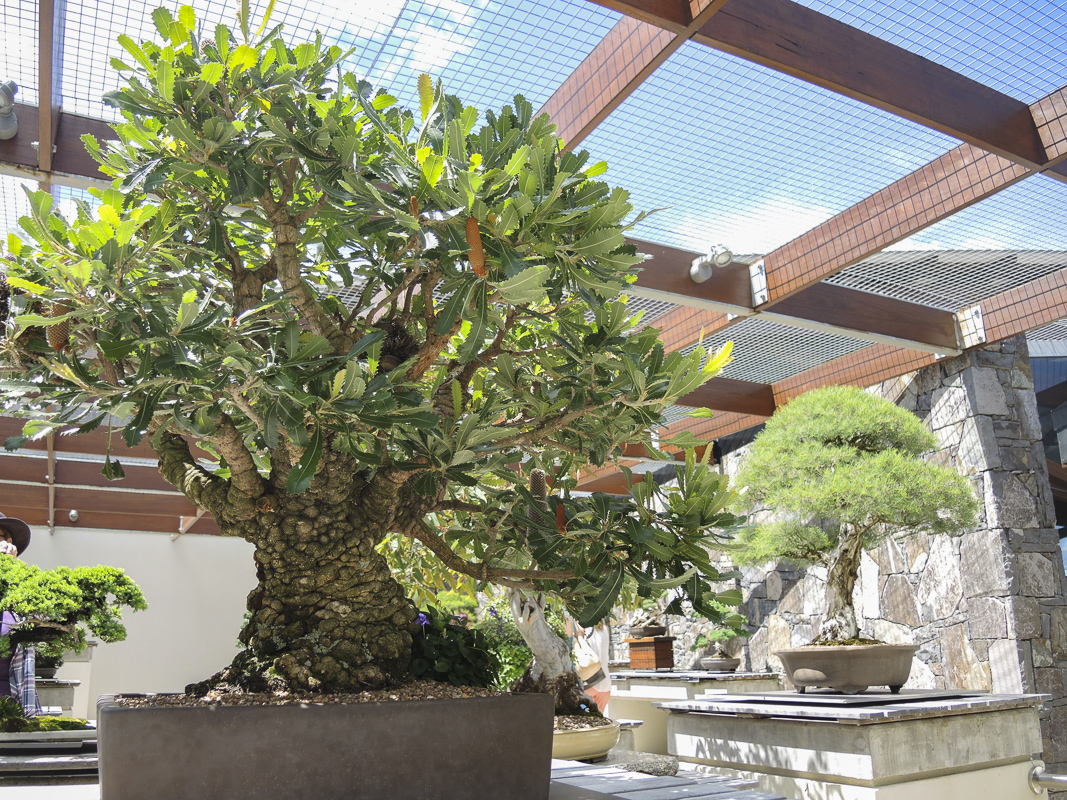
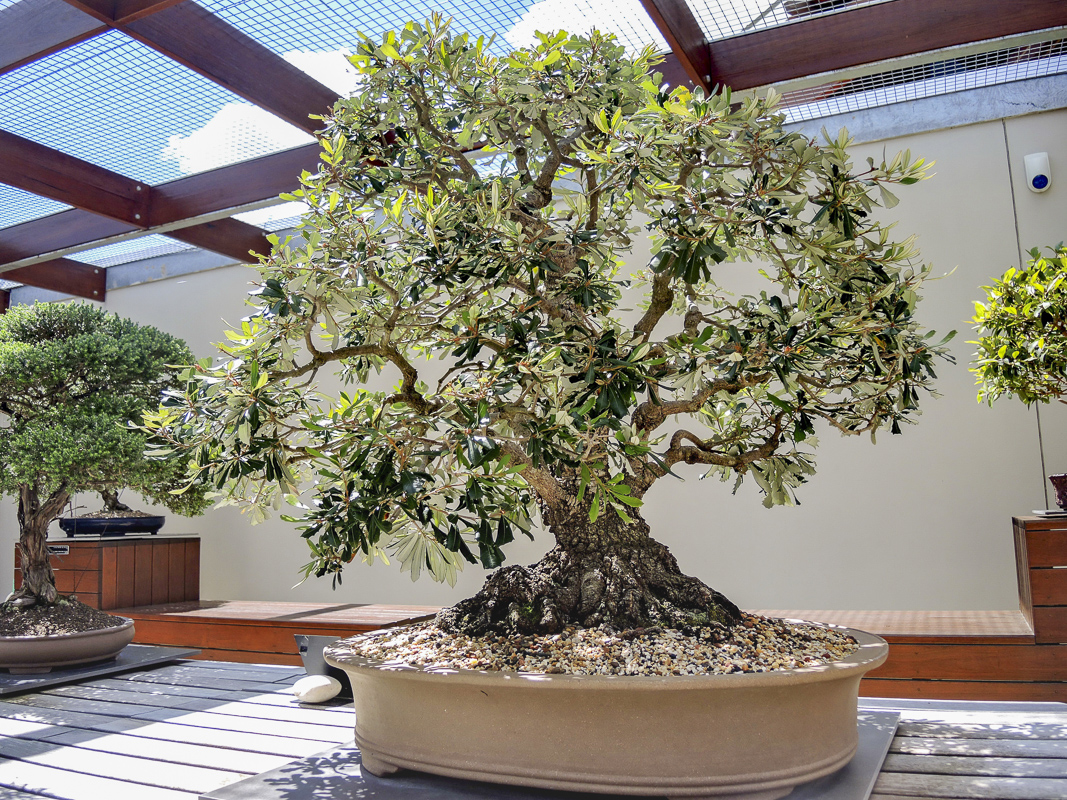
Brachychiton

Brachychiton don’t need a lot of water and will thrive on “benign neglect”. Brachychitons prefer a sunny window. Brachychiton rupestris (Queensland Bottle Tree) is the best for bonsai, and will grow in any temperature range from 4 to 24 C (40 to 75 F). Protect from sudden cold drafts. Its na,e os “Bottle Tree” because of its large, bulbous trunk and roots formed to conserve water. B. populneus (Kurrajong) is faster growing and will tolerate temperatures down to -4 C (25 F). The cooler they are, the less water they need.
Bonsai of Brachychiton Image John Holzapfel
The best way to take advantage of their interesting trunks and roots is to follow this procedure:
- Plant your tree in a one-gallon thin plastic pot (available at any nursery).
- Allow the tree to grow in a sunny window without pruning the branches.
- When the trunk reaches 50 mm (2 inches) or so in width, slice 25 mm (1 inch) off the top of your pot and remove the same amount of soil.
- Continue this procedure once a month until you have exposed 100-150 mm (4-6 inches) of strong taproots.
- Using pruning shears, cut the trunk back to the lowest three branches.
- In spring, remove the plant from the pot and slice horizontally through the root ball, cutting away about half of the tree’s roots.
- Repot into a bonsai pot and keep warm and barely moist for one month while the new roots form. Cut back branches at any time to create a bushy appearance. The results will be
- impressive.
Callistemon
These evergreen shrubs or small trees produce amazing red, purplish, or yellow flowers. The flowers are actually long spikes of tiny flowers with very long stamens, giving these plants the nickname “bottlebrush”. If you can provide cool conditions in winter (not under 10 C; 50 F) and a sunny position in summer, these plants will be easy to grow.
They are quite vigorous, and require heavy pruning after flowering. Water and fertilize heavily in summer, but keep on the dry side during winter. Although they do need sun, they will survive the winter under fluorescent light if conditions are cool, so try placing them in a basement near a window under a standard shop light. Move them outside in spring.
The best for bonsai is Callistemon citrinus (Lemon Bottlebrush) with tiny leaves and 100mm (4 inch) flowers. C.speciosus (Bottlebrush) has the showiest flowers, 125mm (5 inches) long with huge red stamens, but the large leaves are difficult to reduce.
Eucalypts
Evergreen trees and shrubs with beautiful bluish-green leaves. These plants will thrive in any soil, under any conditions, as long as they have sun. They are extremely durable and adaptable in the home, and will tolerate light shade and winter warmth better than most other Australian plants. They are an excellent choice for the beginner. Since they are rapid growers, the only difference between a good job of pruning and a bad one will be about two weeks.
Stand them outside in full sun for the summer to get the best, most compact growth. Water thoroughly from spring to autumn, sparingly in winter. Keep them potbound or they will take over the house. The best are Eucalyptus globulus (Tasmanian blue gum) with striking blue leaves and rapid growth, E. gunni (Cedar gum) which is slower growing, and Corymbia citriodora (Lemon scented gum).

Ficus and Clerodendron
Ficus and Clerodendron are very amenable to bonsai culture as seen below.
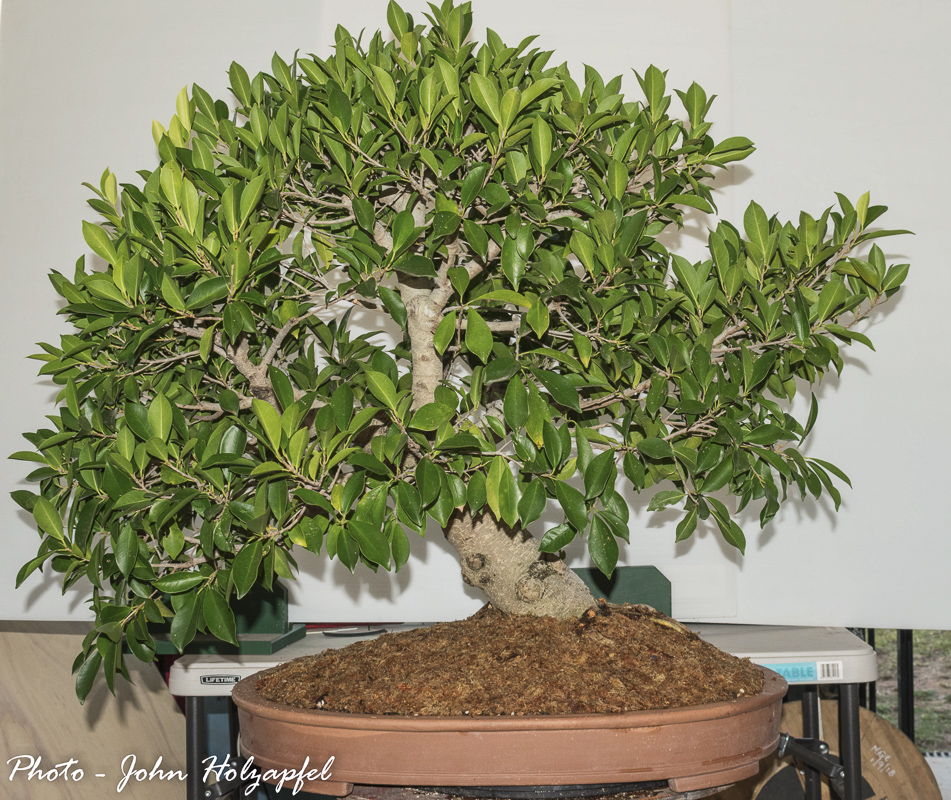
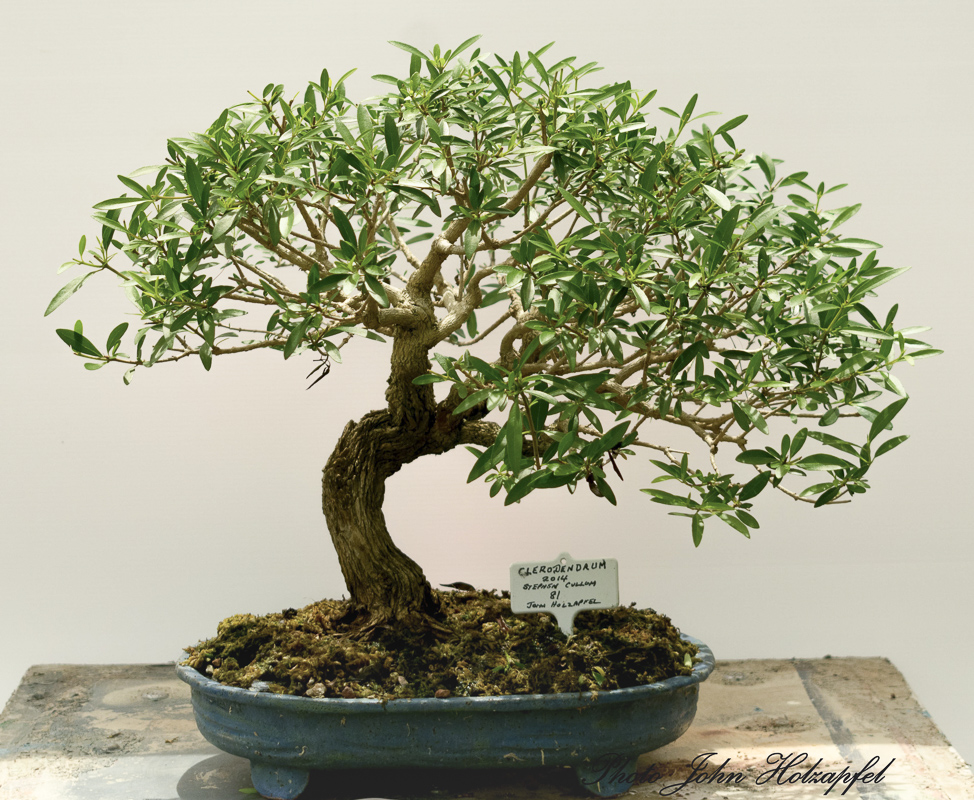
Grevillea
Grevilleas are evergreen shrubs and trees, mostly grown for their showy foliage. Many have beautiful flowers. Grevillea robusta (Silky Oak) is the commonly grown, because it tolerates light shade and some winter warmth. These trees require additional humidity to keep their foliage attractive in winter. Use a humidifier, and do not place them near a heat source. These are a rapid growers, which can go from seed to ceiling in about five years. Don’t be afraid to cut them back at any time. If you wish to grow a large tree, minimize your pruning and you may get a show of white flowers in spring. The best Grevillea for bonsai is G. rosmarinifolia, which has tiny, needle-like leaves and adorable red (occasionally pink or white) flowers carried in handsome yellow bracts. This plant must have a cool winter to bloom successfully. Highly recommended.
Melaleuca
These evergreen trees and shrubs are absolute knockouts as bonsai. They are pest-free, tolerant of light shade and winter warmth, easy to propagate by seed or cutting, and just plain good natured. Young branches have beautiful black bark, aging to white. The trunks show off with papery, exfoliating bark that becomes more marked with age.
Melaleuca leucodendron (Cajuput, River Tea Tree) has large leaves that will reduce with bonsai culture. The flowers may be white, yellowish-green, pink, or purple, in 75-200 mm (3-8 inch) spikes. At the nursery, plants sold by this name are quite often actually Melaleuca quinquenervia, which has a much whiter bark, smaller leaves (35 mm or 1.5 inches) and always blooms white. If you have the opportunity to have this sort of accident, don’t pass it up! This tree, which I purchased accidentally under the wrong name, is my absolute favourite and the one most noticed by my friends. For anyone who has limited space or has never seen it, this should be your first choice for Australian bonsai. Care is as for Grevillea robusta.
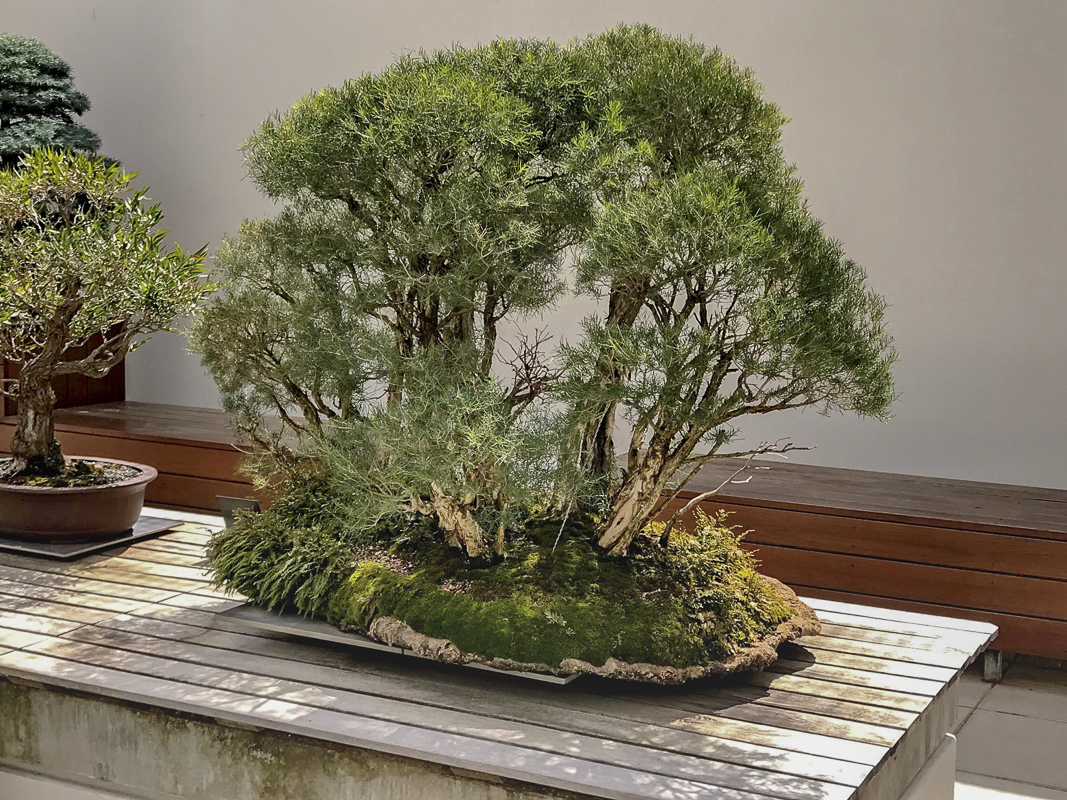
Further Information
For more detailed information, there are a number of sites of bonsai enthusiasts focusing on bonsai of native plants, found by Googling.
This article was edited from the original by April Daly, at https://anpsa.org.au/APOL6/jun97-3.html
April Daly is a 30 year old resident of Chicago, Illinios. She is a former business consultant, now happily unemployed and a keen exponent of bonsai culture. Currently she is maintaining about 70 plants. This article is based on growing experiences in the northern hemisphere but Australian growers should find the advice invaluable for developing bonsai downunder.
 Australian Native Plants Society (Australia)
Australian Native Plants Society (Australia)












